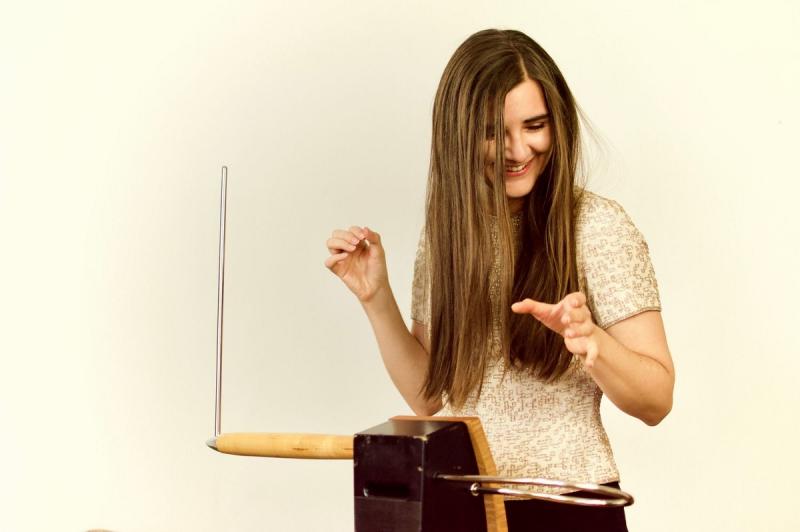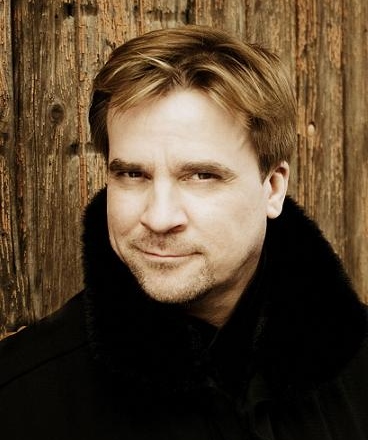Eyck, BBC Philharmonic, Storgårds, Bridgewater Hall, Manchester review - theremin takes centre stage | reviews, news & interviews
Eyck, BBC Philharmonic, Storgårds, Bridgewater Hall, Manchester review - theremin takes centre stage
Eyck, BBC Philharmonic, Storgårds, Bridgewater Hall, Manchester review - theremin takes centre stage
A rare visitor for the UK premiere of Kalevi Aho's 'Eight Seasons'

The theremin is still a relatively rare visitor to concert halls, particularly in a solo role, but Carolina Eyck is changing that.
In many ways its most daunting characteristic is the sheer range of sounds it can create. The right hand controls pitch, and that can vary over a wide range of the normally audible spectrum, with the distinctive notes of conventional scales or freewheeling portamento; the left controls volume, which in practice means articulation as well as power, as it’s responsible for the "envelope" of everything we hear.
It’s also possible to switch the monophonic output between different tone qualities – on the evidence of last night it can be made to sound like a solo cello, or a Wurlitzer-like tibia flute, or something akin to a diapason or clarinet as evoked by a combinative electronic instrument such as a Hammond. Or you can throw caution to the winds and go for wild, wailing modulations like we used to get on Long Wave radio when searching for a station wavelength, or imitate birdsong quite effectively.
Kalevi Aho’s Concerto for Theremin, titled Eight Seasons, written for Carolina Eyck and recorded by her with John Storgårds and the Lapland Chamber Orchestra in 2014, uses all those devices but wisely keeps to sounds that are identifiably musical, most of the time. This was its UK premiere. We’re in programme music territory, the structure of the piece being built from the eight seasons of the year known to the Sámi people of Lapland – beginning with harvest, moving on to autumn, the coming of snow, darkness, frost, frozen snow, melting ice and then the midnight sun. Percussion and strings are often used to evoke the weather effects, and in the most extreme of them the music becomes furiously graphic – you can almost see the snow flurries – in a way that would not disgrace a David Attenborough film about the world’s most hostile environments. Aho likes to use the best ideas from the classical tradition’s masters, whether it’s freezing sul ponticello string tones or rich multi-part chording.

With the full-strength orchestra on stage, they followed it with Outi Tarkiainen’s Midnight Sun Variations, a 10-minute piece they performed together in the recent Proms, which is also very evocative of the Nordic climate and builds to a massive climax of sound, with echoes (it seems to me) of the textures, harmonies and energy of some of Sibelius’s depictions.
The big piece of the evening was Shostakovich’s Symphony No. 12, the one he sub-titled The Year 1917. John Storgårds (pictured above) is working on the later Shostakovich symphonies with the Philharmonic (in the Prom programme it was No. 11): this is both one of the more straightforward and one of the most difficult.
It’s conventional - by 20th century standards - in cyclic, four-movement structure and a journey from grimness to triumph – as of course befitted music about the dawn of the glorious era of Soviet Communism. The opening boasted superb string tone (the orchestra under the leadership of Yuri Torchinsky) whether in militaristic or warm and vital mood, and there were very distinguished contributions from the wind principals, and indeed all the wind players collectively, throughout the work.
Its puzzle lies in what it’s saying beneath the surface – if there is in fact anything to hear beyond how to write an optimistic symphony. Storgårds marked the point where, near the end, you think everything’s working up to the biggest climax of all and then are suddenly made to step back and contemplate something quieter and more thoughtful. After that, though, it’s straight on to the last thwack of the big bass drum, when all is victory.
That last thwack – and many before it, no doubt – earned percussionist Rob Lea a special moment of applause and glory ahead of everyone else, at the end, as with it he retired after a long and distinguished career with the Philharmonic. What a way to go!
rating
Explore topics
Share this article
The future of Arts Journalism
You can stop theartsdesk.com closing!
We urgently need financing to survive. Our fundraising drive has thus far raised £49,000 but we need to reach £100,000 or we will be forced to close. Please contribute here: https://gofund.me/c3f6033d
And if you can forward this information to anyone who might assist, we’d be grateful.

Subscribe to theartsdesk.com
Thank you for continuing to read our work on theartsdesk.com. For unlimited access to every article in its entirety, including our archive of more than 15,000 pieces, we're asking for £5 per month or £40 per year. We feel it's a very good deal, and hope you do too.
To take a subscription now simply click here.
And if you're looking for that extra gift for a friend or family member, why not treat them to a theartsdesk.com gift subscription?
more Classical music
 Echo Vocal Ensemble, Latto, Union Chapel review - eclectic choral programme garlanded with dance
Beautiful singing at the heart of an imaginative and stylistically varied concert
Echo Vocal Ensemble, Latto, Union Chapel review - eclectic choral programme garlanded with dance
Beautiful singing at the heart of an imaginative and stylistically varied concert
 Scott, Irish Baroque Orchestra, Whelan, RIAM, Dublin review - towards a Mozart masterpiece
Characteristic joy and enlightenment from this team, but a valveless horn brings problems
Scott, Irish Baroque Orchestra, Whelan, RIAM, Dublin review - towards a Mozart masterpiece
Characteristic joy and enlightenment from this team, but a valveless horn brings problems
 Classical CDs: Voice flutes, flugelhorns and froth
Baroque sonatas, English orchestral music and an emotionally-charged vocal recital
Classical CDs: Voice flutes, flugelhorns and froth
Baroque sonatas, English orchestral music and an emotionally-charged vocal recital
 Kanneh-Mason, Britten Sinfonia, Shave, Milton Court - a grin and a big beaming smile
A pair of striking contemporary pieces alongside two old favourites
Kanneh-Mason, Britten Sinfonia, Shave, Milton Court - a grin and a big beaming smile
A pair of striking contemporary pieces alongside two old favourites
 theartsdesk at the New Ross Piano Festival - Finghin Collins’ musical rainbow
From revelatory Bach played with astounding maturity by a 22 year old to four-hand jazz
theartsdesk at the New Ross Piano Festival - Finghin Collins’ musical rainbow
From revelatory Bach played with astounding maturity by a 22 year old to four-hand jazz
 First Person: Manchester Camerata's Head of Artistic Planning Clara Marshall Cawley on questioning the status quo
Five days of free events with all sorts of audiences around Manchester starts tomorrow
First Person: Manchester Camerata's Head of Artistic Planning Clara Marshall Cawley on questioning the status quo
Five days of free events with all sorts of audiences around Manchester starts tomorrow
 Goldscheider, Brother Tree Sound, Kings Place review - music of hope from a young composer
Unusual combination of horn, strings and electronics makes for some intriguing listening
Goldscheider, Brother Tree Sound, Kings Place review - music of hope from a young composer
Unusual combination of horn, strings and electronics makes for some intriguing listening
 theartsdesk Q&A: composer Donghoon Shin on his new concerto for pianist Seong-Jin Cho
Classical music makes its debut at London's K-Music Festival
theartsdesk Q&A: composer Donghoon Shin on his new concerto for pianist Seong-Jin Cho
Classical music makes its debut at London's K-Music Festival
 Helleur-Simcock, Hallé, Wong, Bridgewater Hall, Manchester review - moving lyricism in Elgar’s concerto
Season opener brings lyrical beauty, crisp confidence and a proper Romantic wallow
Helleur-Simcock, Hallé, Wong, Bridgewater Hall, Manchester review - moving lyricism in Elgar’s concerto
Season opener brings lyrical beauty, crisp confidence and a proper Romantic wallow
 Kohout, Spence, Braun, Manchester Camerata, Huth, RNCM, Manchester review - joy, insight, imagination and unanimity
Celebration of the past with stars of the future at the Royal Northern College
Kohout, Spence, Braun, Manchester Camerata, Huth, RNCM, Manchester review - joy, insight, imagination and unanimity
Celebration of the past with stars of the future at the Royal Northern College

Add comment